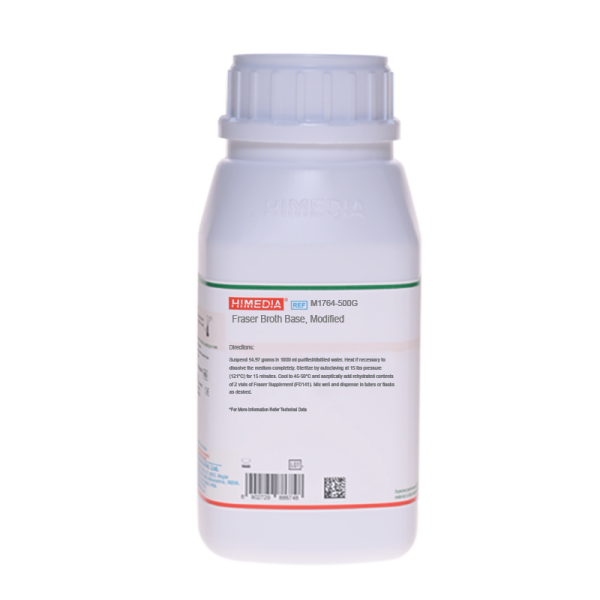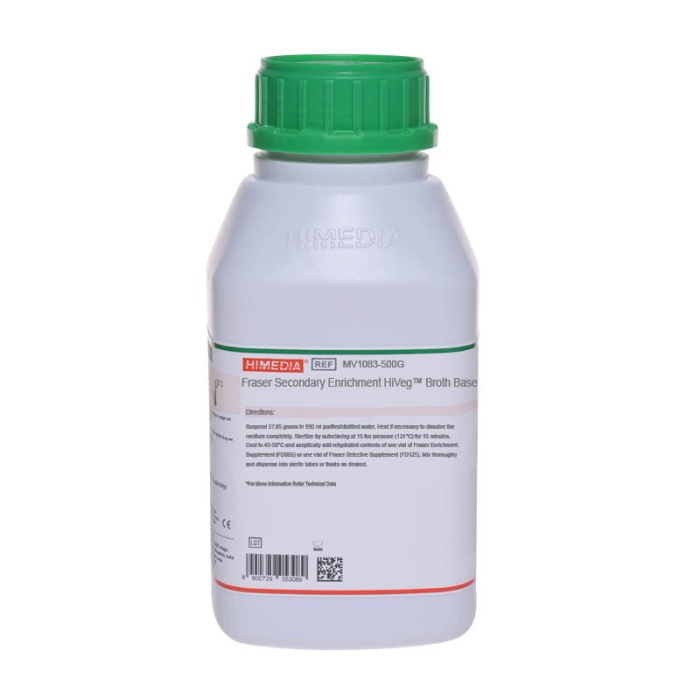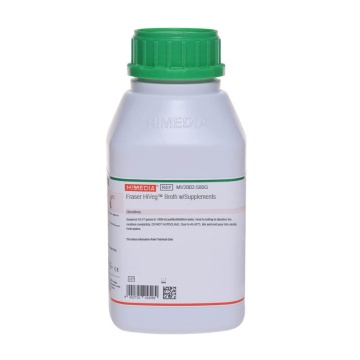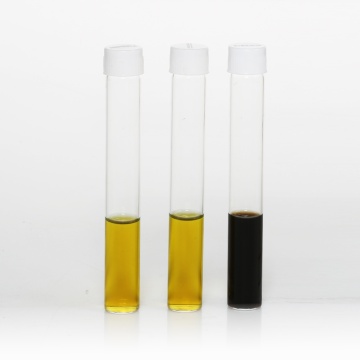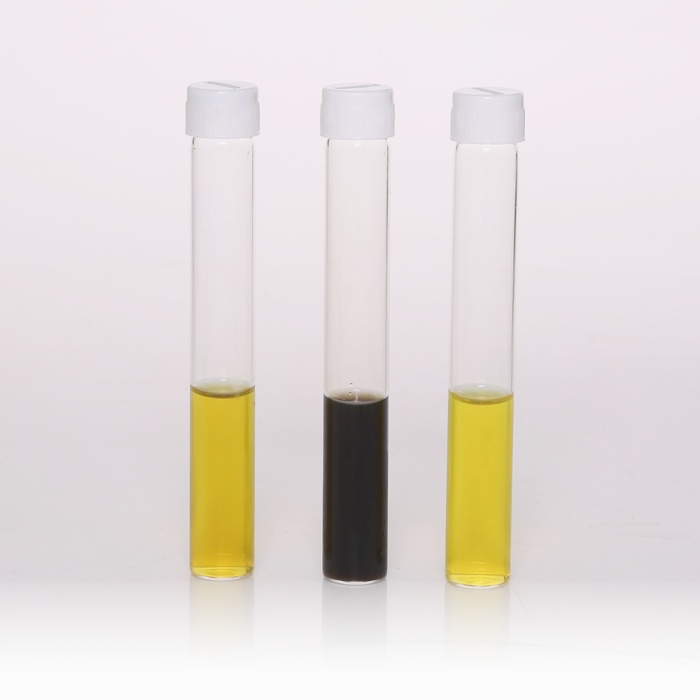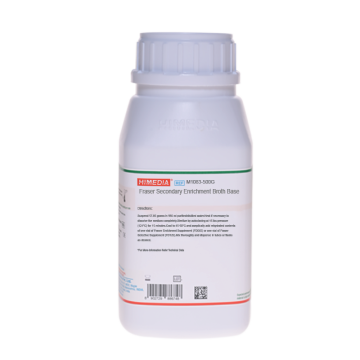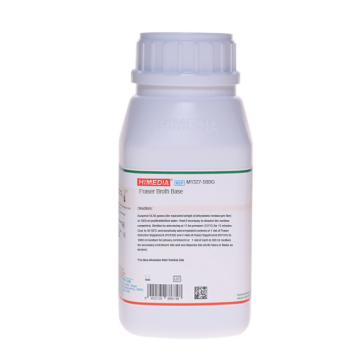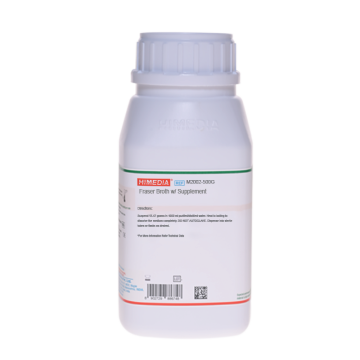 Your enquiry has been submitted
Your enquiry has been submitted
Fraser Broth Base, Modified (Half Fraser Broth)
Intended use
It is recommended for the selective enrichment of Listeria species from foods.
Composition**
| Ingredients | g / L |
|---|---|
| Peptone | 5.000 |
| Tryptone | 5.000 |
| Yeast extract | 5.000 |
| HM Peptone B # | 5.000 |
| Sodium chloride | 20.000 |
| Lithium chloride | 3.000 |
| Disodium hydrogen phosphate | 9.600 |
| Potassium dihydrogen phosphate | 1.350 |
| Esculin | 1.000 |
| Nalidixic acid | 0.010 |
| Acriflavin | 0.0125 |
Final pH (at 25°C): 7.2±0.2
**Formula adjusted, standardized to suit performance parameters
Key : # - Equivalent to Beef extract
Directions
Suspend 54.97 grams in 1000 ml purified / distilled water. Heat if necessary to dissolve the medium completely. Sterilize by autoclaving at 15 lbs pressure (121°C) for 15 minutes. Cool to 45-50°C and aseptically add rehydrated contents of 2 vials of Fraser Supplement (FD141). Mix well and dispense as desired.
Principle And Interpretation
Listeria species are widely distributed and are isolated from soil, decaying vegetable matter, sewage, water, animal feed, fresh and frozen poultry, meats, raw milk, cheese and asymptomatic human and animal carriers (1). Only Listeria monocytogenes from the genus Listeria; causes infections in humans. L.monocytogenes primarily causes meningitis, encephalitis or septicemia in humans (2,3). In pregnant women, Listeria monocytogenes often causes an influenza like bacteremic illness that, if untreated, may lead to amnionitis and infection of the fetus, resulting in abortion, still birth or premature birth. Contaminated foods are the primary vehicles of transmission (4).
Fraser Broth Base, Modified is based on the formulation by Fraser and Sperber (5). It is recommended for selective enrichment of Listeria species from foods. This medium contains peptone, Tryptone, yeast extract and HM Peptone B which provide essential nutrients like carbon and nitrogenous compounds including vitamins, amino acids and trace ingredients. Phosphates buffer the medium while sodium chloride maintains osmotic equilibrium. Nalidixic acid and Acriflavin inhibits the growth of gram-negative and gram-positive organisms respectively except Listeria species (6,7,8). Listeria species hydrolyze esculin to glucose and esculetin. The latter combines with ferric ions of ferric ammonium citrate (FD141), resulting in the formation of 6-7 dihydroxycoumarin, a black brown complex. Ferric ammonium citrate also enhances the growth of L. monocytogenes (9). The high salt tolerance (of sodium chloride) of Listeria is used as means to inhibit the growth of Enterococci. Lithium chloride is also used to inhibit Enterococci, which also possess the ability to hydrolyze esculin.
Type of specimen
Food samples : meat and meat products; Dairy samples.
Specimen Collection and Handling
For food and dairy samples, follow appropriate techniques for sample collection and processing as per guidelines (10,4,1). After use, contaminated materials must be sterilized by autoclaving before discarding.
Warning and Precautions
Read the label before opening the container. Wear protective gloves/protective clothing/eye protection/ face protection. Follow good microbiological lab practices while handling specimens and culture. Standard precautions as per established guidelines should be followed while handling specimens. Safety guidelines may be referred in individual safety data sheets.
Limitations
- Due to variable nutritional requirements, some strains show poor growth on this medium.
Performance and Evaluation
Performance of the medium is expected when used as per the direction on the label within the expiry period when stored at recommended temperature.
Quality Control
Appearance: Cream to yellow homogeneous free flowing powder
Colour and Clarity of prepared medium: Fluorescent yellow coloured clear solution.
Reaction: Reaction of 5.5% w/v aqueous solution at 25°C. pH : 7.2±0.2
pH: 7.00-7.40
Cultural response: Cultural characteristics observed on addition of FD141 after an incubation at 35 - 37°C for 24-48 hours.
| Organism | Inoculum (CFU) | Growth | Esculin Hydrolysis |
|---|---|---|---|
| Escherichia coli ATCC 25922 (00013*) | >=104 | inhibited | |
| Enterococcus faecalis ATCC 29212 (00087*) | 50-100 | none-poor | |
| Listeria monocytogenes ATCC 19111 (00020*) | 50-100 | good-luxuriant | positive reaction, blackening of medium |
| Listeria monocytogenes ATCC 19112 | 50-100 | good-luxuriant | positive reaction, blackening of medium |
| Listeria monocytogenes ATCC 19117 | 50-100 | good-luxuriant | positive reaction, blackening of medium |
| Listeria monocytogenes ATCC 19118 | 50-100 | good-luxuriant | positive reaction, blackening of medium |
| Staphylococcus aureus subsp. aureus ATCC 25923 (00034*) | 50-100 | none-poor |
Key : (*) - Corresponding WDCM numbers
Storage and Shelf Life
Store the dehydrated powder and prepared medium on receipt between 2-8°C. Use before expiry date on the label. On opening, product should be properly stored dry, after tightly capping the bottle in order to prevent lump formation due to the hygroscopic nature of the product. Improper storage of the product may lead to lump formation. Store in dry ventilated area protected from extremes of temperature and sources of ignition Seal the container tightly after use. Product performance is best if used within stated expiry period.
Disposal
User must ensure safe disposal by autoclaving and/or incineration of used or unusable preparations of this product. Follow established laboratory procedures in disposing of infectious materials and material that comes into contact with sample must be decontaminated and disposed of in accordance with current laboratory techniques (6,7).
Reference
- Seeliger H. P. R., and Jones D., 1986, Bergeys Manual of Systematic Bacteriology, Vol. The Williams and Wilkins Co., Baltimore.
- Nieman R. E., and Lorber B., 1980, Rev. Infect. Dis. 2 : 207-227.
- Schuchat A. B., Swaminathan and C. V. Broome, Clin. Microbiol. Rev. 4: 169-183.
- Murray P. R., Baron E. J., Jorgensen J. H., Pfaller M. A., Yolken R. H., (Eds.), 8th Ed., 2003, Manual of Clinical Microbiology, ASM, Washington, D.C.
- Fraser , J., and W. Sperber. 1988. Rapid detection of Listeria in food and environmental samples by esculin hydrolysis. Journal of Food Protection 51: 762-765.
- Isenberg, H.D. Clinical Microbiology Procedures Handbook 2nd Edition.
- Jorgensen, J.H., Pfaller, M.A., Carroll, K.C., Funke, G., Landry, M.L., Richter, S.S and Warnock., D.W. (2015) Manual of Clinical Microbiology, 11th Edition. Vol. 1.
- Lee W.K. and McClain D., 1986, Appl. Environ. Microbiol., 52:1215.
- Cowart R. E. and Foster B. G., 1985, J. Infect. Dis.; 151:172.
- Lovette J., Francis D.W. and Hunt J.M., 1987, J. Food Prot., 50:188.
| Product Name | Fraser Broth Base, Modified (Half Fraser Broth) |
|---|---|
| SKU | M1764 |
| Product Type | Regular |
| Physical Form | Powder |
| Origin | Animal |
| Packaging type | HDPE |
| References | 1.Seeliger H. P. R., and Jones D., 1986, Bergeys Manual of Systematic Bacteriology, Vol. The Williams and Wilkins Co.,Baltimore.2.Nieman R. E., and Lorber B., 1980, Rev. Infect. Dis. 2 : 207-227.3.Schuchat A. B., Swaminathan and C. V. Broome, Clin. Microbiol. Rev. 4: 169-183.4.Murray P. R., Baron E. J., Jorgensen J. H., Pfaller M. A., Yolken R. H., (Eds.), 8th Ed., 2003, Manual of Clinical Microbiology,ASM, Washington, D.C.5.Lovette J., Francis D.W. and Hunt J.M., 1987, J. Food Prot., 50:188.6.Lee W.K. and McClain D., 1986, Appl. Environ. Microbiol., 52:1215.7.McClain D. and Lee W.H., 1988, J. Assoc. Off. Anal. Chem., 71:660.8.Cowart R. E. and Foster B. G., 1985, J. Infect. Dis.; 151:172.9.Fraser , J., and W. Sperber. 198 |
| Customized Product Available | No |



